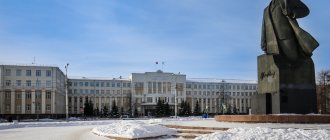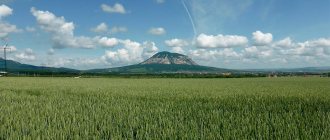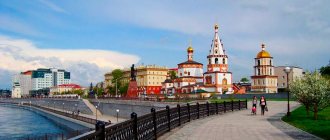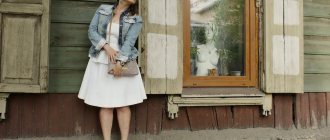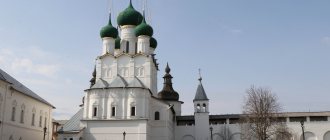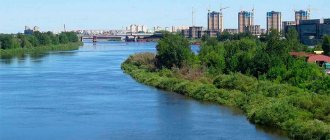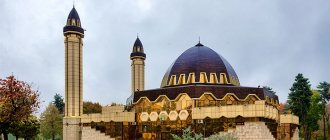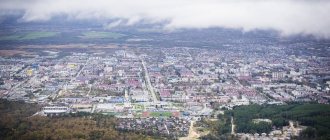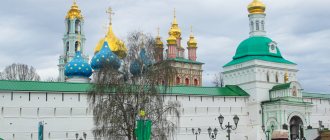| Sights Museums Where to go with children Where to go from Rostov Reviews of tourists Where to stay in Rostov Excursions |
For one thousand and one hundred and fifty years, Rostov, the regional center of the Yaroslavl region, has stood on the shores of Lake Nero. In the past, it was the capital of the principality, a large city in the north-west of Rus', Rostov the Great. The names of Yaroslav the Wise, the son of Vsevolod the Big Nest, and Ivan the Terrible are associated with him. The events of the chronicle will be briefly described on its main page on this site. Today the city preserves a piece of Russian history: in winter people come to Rostov to see ancient churches and chambers, plunge into their atmosphere, admire the expanse of the snow-covered lake and see an amazing panorama from it, above which onion domes rise. Rostov the Great is the city of the Golden Ring of Russia.
Attractions
A walk around Rostov does not require serious preparation or studying maps: the city center is compact, most of the places of interest to tourists are located around the Kremlin. You can get to the monasteries on the outskirts by bus, or if you wish, you can walk, the distance is short.
Lake Nero Photo: © Anna Strukova
Rostov Kremlin
It is impossible to imagine Rostov the Great without its Kremlin. Of course, this is an integral part of the city and a prominent landmark. White walls and churches form a harmonious ensemble, it rises above the city and Lake Nero. The Kremlin is beautiful at any time of the year, but is especially charming in white winter. The oldest one in it is the Assumption Cathedral , built at the beginning of the 16th century; most of the other buildings date back to the second half of the 17th century. and erected under Metropolitan Ion Sysoevich. Since 1883 it has functioned as a museum and currently has the status of a museum-reserve.
The Kremlin will seem familiar to many: it became the site for the historical scenes of L. Gaidai’s film “Ivan Vasilyevich Changes His Profession.” Unfortunately, you won’t be able to climb the fortress walls like the heroes in winter, nor will you be able to see the frescoes of the temples (open from May to mid-October).
Church of St. John the Evangelist and Church of Hodegetria in the Rostov Kremlin Photo: © Anna Strukova
However, this does not make the winter views of the attraction any less attractive. In winter, on a small lake in the center of the Kremlin, there is an ice skating rink and skate rentals, and local cafes offer hot drinks. For the New Year and Christmas holidays, the museum-reserve organizes a whole program of interactive historical excursions , games, dances, performances and master classes for the whole family. The Kremlin supports the ancient traditions of Maslenitsa with fun activities, bright outfits and delicious pancakes.
At any time of the year, guests can see the architecture of the Kremlin and exhibitions inside the buildings. But please note that the museum-reserve has weekends. Entrance tickets are offered both for individual halls and as a package.
The Rostov Kremlin is divided into three zones. The Cathedral Square is occupied by the Assumption Cathedral and its belfry with 15 original bells, and is limited to the north by the Rostov shopping arcades . The bishop's courtyard consists of the churches of St. John the Evangelist , Hodegetria and Savior on Senya , the White and Red Chambers . The southern part is the Metropolitan Garden .
Assumption Cathedral in Rostov Photo: © Victor Bashkir
Exhibitions of the museum-reserve:
- Museum of Enamel - an extensive collection of enamel art products, located in the Judgment Prikaz;
- “Treasures of the Rostov Kremlin” - silver, icons, clergy clothes and other ancient church attributes; located in the Church of Hodegetria;
- The Museum of Church Antiquities occupies the White Chamber;
- several exhibitions, including those about the history of Rostov land, are open in the Red Chamber;
- open storage of the fund - archaeological collections are presented in the Storeroom Chamber;
- "Bells and Bells" is also on display in the Storeroom;
- The “Exhibition of Carriages, Sleighs and Bicycles” takes place on the territory of the Konyushenny Dvor, located near the western wall of the Kremlin.
Read more: Rostov Kremlin
Panorama of the city and the Kremlin in Rostov Photo: © Anna Strukova
Avraamiev Epiphany Monastery
Avraamiev Epiphany Convent is located on the north-eastern outskirts of Rostov, on the shore of Lake Nero. The exact time of its foundation is unknown; the range of possible dates is quite wide: from the 10th to the 13th centuries. The appearance of the monastery is associated with the activities of the Monk Abraham, who lived on Rostov soil. According to legend, with the help of a cane given by John the Theologian, Araami defeated the wooden idol of the pagan god Veles, after which a temple was erected in its place.
The strong monastery walls were destroyed in the 1930s. Today, the most venerable building of the monastery is the Epiphany Cathedral . It was set up by Ivan the Terrible at the end of the campaign against Kazan, since the success of the event correlated with the cane of Abraham taken into it. Later buildings include the St. Nicholas and Vvedenskaya churches . The monastery operates and is gradually reconstructing its facilities.
Read more: Avraamiev Epiphany Monastery
Spaso-Yakovlevsky Monastery
Another ancient monastery is located on the banks of the Nero south of the city center. Rostov Spaso-Yakovlevsky Dimitrievsky Monastery was founded at the end of the 16th century. Saint James. But, as in the case of the first, the wooden buildings did not survive and only the stone ones from the second half of the 17th century have survived to this day. The volume of the three internal cathedrals is impressive : Dimitrievsky, Zachatievsky the Yakovlevskaya Church attached to it . In their decoration you can see ancient frescoes of the late 17th - 18th centuries. On the territory of the monastery are the relics of the founder Jacob and the Rostov Metropolitan Dimitri of Rostov, who served at the beginning of the 18th century.
The monastery is surrounded by a wall, from one of the towers of which, regardless of the time of year, there is a good view of the surrounding area and the lake. Not far from the western wall rises the Church of the Transfiguration of the Lord - the only one from the Spaso-Pesotsky Monastery , and now part of the Spaso-Yakovlevsky Monastery. Since the 1990s The restoration of the integrity of the churches continues after the abolition of the monastery during the Soviet years.
Read more: Spaso-Yakovlevsky Monastery
Spaso-Yakovlevsky Monastery Photo: © Victor Bashkir
Trinity-Sergius Varnitsky Monastery
On the third, western side of Rostov stands the Trinity-Sergius Varnitsky Monastery. It was built in the second quarter of the 15th century. in Varnitsa - the place where one of the most famous Russian saints, Sergius of Radonezh, was born. At the same time, the monastery was not popular and had difficulty providing itself with the necessities. Only centuries later did eminent nobles begin to donate funds to her. However, the revolution of the 20th century. negated all achievements: the monastery was almost completely destroyed.
Today, the Trinity-Sergius Varnitsa Monastery has been restored and is a major spiritual center of the region. It operates an Orthodox gymnasium, and excursions are organized for guests, there is a hotel and a refectory.
Read more: Trinity-Sergius Varnitsky Monastery
Cathedral of St. Sergius of Radonezh in the Varnitsky Monastery Photo: © Lyudmila_Klyopova
Church of the Ascension
There are dozens of churches in Rostov, resurrected or forgotten, but you cannot miss the oldest of them. The Church of the Ascension of the Lord on the Ramparts, or also the Church of Isidore the Blessed, is located near the center surrounded by an earthen rampart - the bastion of the Rostov Fortress , which is especially clearly visible on the map.
It was erected in 1566 by decree of Ivan IV over the resting place of the Rostov holy fool - Saint Isidore. The temple is a monument of ancient Russian architecture. The paintings inside it have been preserved, but they were made a couple of centuries later. Later, a bell tower built in the traditions of classicism also grew nearby.
Read more: Church of the Ascension in Rostov
Church of the Ascension in the Ramparts Photo: © Kalusha
More sights of Rostov
Neighborhood
Spaso-Yakovlevsky Dimitriev Monastery
From the lake you can see the ancient Spaso-Yakovlevsky Dimitriev monastery, founded in the 14th century. Most of the surviving buildings were built later, and their architecture is significantly different from the Kremlin - it is more classical and baroque style. The monastery's cathedrals will also be of interest for their ancient frescoes.
Church of St. John the Evangelist on Ishna
Another important attraction is the Church of St. John the Theologian, which is located in the vicinity of Rostov in the Bogoslov area. It was built in 1687 and is a unique wooden monument preserved from that time. You can see many carved elements in the temple. Inside there is a copy of the Royal Doors from 1562.
village of Bogoslov
Working hours: 10:00-17:00
Entrance: 80 rub.
Museums
In Rostov it is not difficult to find classic museum exhibitions about its history. Most of them are located within the walls of the Kremlin, in the Rostov Kremlin Museum-Reserve, noted above. But the other half remains unmarked - the opposite of strict shop windows and reverently silent churches. These are exhibitions dedicated to everyday life and local crafts. The museums are small, and excursions around them are a real theatrical experience. They easily and vividly tell their Rostov story. Several of them are located close to each other at the intersection of the street. Leninskaya and Frunze.
Museum of Rostov Merchants
The Museum of Rostov Merchants is a department of the Rostov Kremlin Museum-Reserve. It occupies an estate from the late 18th to early 20th centuries. It was owned by the Kekin merchants, prominent philanthropists of those years. Today, antique furniture, dishes and personal belongings of the family represent the Rostov merchants, life, culture, economy and other aspects of their life. A spacious home always impresses guests. Do not refuse a guide: a visit with a story will be more interesting and understandable.
Read more: Museum of Rostov Merchants
Rostov Street Photo: © Maria Penina
Rostov gingerbread
Another mansion belonged to the merchants Pleshanov. Nowadays it is a hotel and gingerbread museum - “Rostov Gingerbread”. The museum will tell the history of the trading house “K. P. Smyslova with his sons,” which existed at the turn of the 19th and early 20th centuries, supplying Rostovites with gingerbread. In the museum you will immerse yourself in local delicacy traditions, learn what gingerbread spirits are, and see historical exhibits - skillful baking molds. The excursion will definitely be memorable: it is conducted by a merchant and his wife, their cook and clerk. Guests are treated to gingerbread cookies and tea and are offered master classes on how to create them. The finished product can be purchased as a tasty souvenir.
What to bring from Rostov the Great
Pleshanova Estate Photo: © Maria Penina
Folk Art Museum
The Folk Art Museum is a collection of ancient household items. Each exhibit is an original representative of its category, an extraordinary example of folk art. Dishes, chests, spinning wheels, icons, towels will delight you with their colors and captivate you with their craftsmanship. Guides who are deeply involved in the topic will tell you not only about the origin and purpose of things. They will tell you about the customs associated with them.
Read more: Folk Art Museum
Exhibits of the Rostov Museum of Folk Art Photo: © olenkacuznetzova
House of Crafts
On the shore of Lake Nero, not far from the Kremlin, in the old house of the Rykunin merchants, there is a “House of Crafts”. The exhibition presents the works of modern masters of folk crafts, which is why the exhibitions are constantly changing. There are ceramics, carved wood, lace, and a designer doll. Among the variety there is a lot that can be purchased as a souvenir.
The House of Crafts organizes master classes in which not only children, but also adults take part with pleasure. Guests are invited to master the pottery wheel or decoupage technique, paint ready-made pipes or create holiday candles. The visit program may include games and folklore performances, but this must be requested in advance.
Read more: House of Crafts in Rostov the Great
Black-polished ceramics in the House of Crafts Photo: © Ivan Yakunin
Rostov Podvorye
The Rostov Compound Museum is another platform about the life and creativity of ancient Rostov. It is located opposite Gostiny Dvor in the building of trading shops of the 18th-19th centuries. The museum has several thematic spaces. One introduces the Merya people, who lived on these lands before the appearance of the city. Another depicts a peasant farmstead, and guests will learn amazing facts, for example, why the Rostovites came up with the idea of melting the lake or why Baba Yaga put Ivanushka on a shovel. The third represents the Rostov fair, its goods and entertainment.
The Rostov Compound organizes many interactive events: master classes, programs on peasant rituals and merchant traditions. On the eve of the New Year, Christmas, Maslenitsa, they are certainly associated with festive traditions. Some include tasting drinks and food, participating in entertainment, games and dances popular over a century ago.
Read more: Museum "Rostov Compound"
Museum "Rostov Compound" Photo: © Official page of the complex "Russian Compound" Vkontakte
Cafe-museum "Lukova Sloboda"
Lukova Sloboda is a small museum where they will tell you about growing onions, the traditions, customs, and superstitions associated with them, and invite you to participate in creative workshops - to create an onion amulet or a doll. But the cafe serving Russian cuisine is most in demand; you will certainly find onion dishes on the menu. The museum is located half a kilometer from the railway station and bus station on the street. Dostoevsky. Next door to it is the theater-restaurant “Pike Dvor”. It is distinguished by a fish theme and a performance based on the famous Russian fairy tale for young guests.
Read more: Lukova Sloboda
Museum "Lukova Sloboda" Photo: © Official website of TC "Rostovsky"
Church of the Savior at Torg
The modern building of the Church of the All-Merciful Savior in Torg was built in the 17th century. Once upon a time it was located between the shopping arcades of Gostiny Dvor, which is why it received such a name. The blue dome is decorated with stars.
Shopping arcades
Like Suzdal or Kostroma, Rostov has its own “Gostiny Dvor” with shopping arcades. This is a typical building for that time in a classical style with arched entrances to each merchant's shop. Together with the church they form a single architectural complex. The rows are still primarily used for trading.
Tolga Church
The Church of the Tolgskaya Icon of the Mother of God is the only city religious institution that continued its work during Soviet times. A neat but elegant temple was built in the 18th century. The relics of John the Merciful are kept inside.
Wiki/Commons
Ascension Church
The ancient Church of the Ascension of the Lord was abandoned for a long time and was plundered several times. Fortunately, the frescoes were preserved, but the unique wooden carved iconostasis was lost.
Museum of Rostov Merchants
In the small mansion, the interiors have been completely recreated and items from merchant life have been preserved. Here you can imagine how provincial merchants lived two centuries ago and get acquainted with the history of the famous Rostov Kekin family.
Leninskaya st., 32
House of Crafts
The House of Crafts contains works of craftsmen engaged in folk crafts and decorative arts. For example, objects made of black-polished ceramics, birch bark and wood carvings. However, this is not a simple exhibition. Here you can take part in master classes and try to learn how to make dolls, products from birch bark or wood. For example, whistle toys, majolica figurines or ceramic pots. Excursions and events dedicated to Russian folklore are regularly organized. The house is located in the very center.
From the website domremesel.com
2nd passage of Tolstoy embankment, 16
Khors Art Gallery
A unique museum, the exhibition of which presents a wide collection of artistic enamel. It contains both ancient works of art and modern art objects by artists from all over Russia. Some of the presented objects can be purchased. In addition to the regular exhibition, exhibitions dedicated to contemporary art and master classes are regularly held for those wishing to master the unusual skill of making objects from enamel.
st. Podozerka, 31
Where to go with children
A snow-white fortress with towers, the Frog Princess, Alyosha Popovich, folk crafts in museum master classes - Rostov the Great takes travelers with children into the world of fairy tales.
The Frog Princess Museum , like many in this city, occupies a merchant's mansion. The plot of the famous fairy tale could well have happened on Rostov soil, because for the indigenous peoples the frog was sacred. In addition to meeting 5,000 frogs of all colors and sizes, young guests will enjoy an interactive game-journey through the fairy tale “The Frog Princess,” where everyone can play the role of a prince or an unusual princess.
Museum “The Frog Princess” Photo: © Maria Penina
At the Compound, Alyosha Popovich and Marya the Mistress will be introduced to the life of the legendary hero, invited to take part in funny competitions and treated to heroic dishes. At master classes at the museum complex, those interested will be taught the secrets of ancient monograms or the patterns of the Rostov whistle.
The Rostov Compound Museum will reveal the history of the past in an accessible and fascinating form . Visitors will learn about the secrets of Lake Nero, ancient rituals, and traditions of celebrating name days. Schoolchildren will be told why the school year began in winter and how the modern ABC differs from the ancient Primer. For the winter holidays, the museum always organizes themed entertainment programs.
Interactive for young tourists Photo: © Svetlana-Bol-Shakova
A couple more places where both children and adults will not get bored, where leisure and lunch are successfully combined.
“Lukova Sloboda” is a cafe-museum dedicated to the history of onions. Don’t worry that the cafe’s menu won’t be to your taste: in addition to onion dishes, there are plenty of other dishes.
“Rostov gingerbread ” is a museum of Rostov gingerbread, a family production that existed in the city at the turn of the 19th-20th centuries. Combining an immersion in history, everyone will be treated to delicious gingerbread and invited to take part in their preparation. On New Year's and Christmas dates, Rostov gingerbread prepares themed excursions and performances for guests.
Showcase of the Alyosha Popovich cafe in Rostov Photo: © Maria Penina
If you continue your journey towards Yaroslavl or, conversely, come from its side, do not miss the Zabava active and family recreation park . It is located at km 244 of the M-8 highway and offers plenty of activities for the whole family in both summer and winter. In the latter case, many attractions are available: an inflatable wheel, sumoball, trampolines, bull rodeo and others, there are places for cheesecake riding, skiing and ice skating. For those who want to experience vivid emotions, there are rope courses and bungee jumping. Shooting range and paintball - for an exciting fight. There is plenty of entertainment here not only on ordinary days: the annual Maslenitsa festivities will be not only fun, but also delicious.
Places for walking
Cathedral Square
Address: Rostov Kremlin
The main square of Rostov the Great is called Cathedral and is located in the heart of the Rostov Kremlin. In ancient times, it served as a gathering place for the people's meeting, where important city problems were resolved and discussed, courts were held, and trade was conducted. Frequent fires changed the size and outline of the square, but its significance as the city center remained unchanged.
At the turn of the 17th-18th centuries, the square was surrounded by a stone wall, and it became part of the Kremlin. Therefore, now, in order to take a walk and enjoy the picturesque views of the churches, you need to visit the Rostov Kremlin.
Lake Nero
How to get there: by car along the street. Spartakovskaya
The unusual name of Lake Nero excites the minds of many city guests. There is a legend that one traveler heading to Rostov lost his way and wandered through the local swamps for several days. When, exhausted from fatigue and hunger, he finally saw the domes of the Rostov churches, he exclaimed: “This is not Ro...”, but before he could finish speaking, he fell struck by an arrow. Since then, the ancient lake began to be called “Nero”
The first people to populate the shores of the lake were the Finno-Ugric peoples. In the 9th century, these places also attracted the attention of the Eastern Slavs, who gave the lake the nickname Rostov. However, the name did not catch on; people continued to call the reservoir “Nero”, which translated from Finno-Ugric means “muddy, swampy place”.
The waters of Nero have been a favorite place for fishermen for several centuries. Today there are also boat and steamship excursions on the lake.
City Park
Address: City Park Telephone: 8 (48536) 6-05-91 Opening hours: 10:00-22:30 Tue.-Sun., Mon. — day off Cost: free
You can admire the water surface of Lake Nero and just have a pleasant rest in the city park. It begins its history in the first half of the nineteenth century. At one time, there were gazebos, a wooden circus and a theater here. A pier for pleasure boats was also built in the park.
In 2012, the City Garden underwent a large-scale reconstruction, which made this place even more attractive and convenient for a pleasant pastime.
Where to go from Rostov
Near Rostov the Great there are several other places recognized by thousands of tourists. Estates, monasteries, museums - they all reveal the history of the region in their own way. Some are conveniently located on the Moscow-Yaroslavl road, while others are a little more difficult to get to.
Boris and Gleb Monastery
Borisoglebsky Monastery is a functioning Orthodox monastery. It is located in the center of the village of the same name, 16 km from Rostov on the road to Uglich. The monastery was founded by the monks Theodore and Paul in the second half of the 14th century, and the place was indicated by Sergius of Radonezh. The relics of the founding saints are located on the territory, as are the relics of St. Irinarch the Recluse. At one time, the monastery was a significant and rich spiritual center of the country.
The main part of the monastery buildings dates back to the 16th - 17th centuries. The oldest here is Boris and Gleb Cathedral . One of several domes has been preserved on it. Sretenskaya and Sergius churches are interesting , each of which stands between strong gate towers. The Church of John the Baptist is also noteworthy : the main volume is crowned by a belfry and a trio of thin domes.
Read more: Boris and Gleb Monastery
Sretenskaya Gate Church of the Boris and Gleb Monastery Photo: © Lyudmila_Klyopova
Goden Cross
40 km south of Rostov, in the village of Godenovo, in the Church of St. John Chrysostom, an important Christian shrine is kept - the Godenovo Cross. The cross is made of linden and is a relief painted image of Christ. Its height is about 2 m. There is little information about the origin: according to legend, in 1423 the cross appeared to shepherds in a swamp near Rostov. But its miraculous power is better known - thousands of pilgrims come to worship the shrine, and cities receive copies of it.
Next to the temple, which belongs to the courtyard of the St. Nicholas Convent in Pereslavl-Zalessky, there is a monument to St. Seraphim of Sarov and a monument to the royal martyrs - the family of Nicholas II.
Read more: Church of St. John Chrysostom
Goden Cross in the Church of St. John Chrysostom Photo: © Lyudmila_Klyopova
Museum-estate of the Leontiev nobles
The Voronino estate is the estate of the Leontyev nobles, located 20 km west of Rostov. In the period from 1760 to 1917. it belonged to several representatives of the clan. Currently, its restoration is being carried out by a direct descendant. The manor house, family crypt, manor park with ponds have been put in order, and the restoration of the bell tower is next.
Tourists come to stroll through the park, feel the tranquility of the outback, visit museum exhibitions dedicated to the Leontiev and Suvorov family, and see a model of the original estate. Guest houses have been built for visitors and there is a restaurant. In winter, skates and skis are available for rent, and entertainment for the whole family is organized during the holidays.
Read more: Leontiev Estate Museum
Manor house of the Leontyev estate Photo: © maximy4
Baklushi Museum and Jam Library
Another place where the whole family is worth going is the Baklusha Museum and the Jam Library, located near the village of Semibratovo on the Yaroslavskoye Highway. “Getting caught up” is not as easy as it seems. Wooden spoons, although simple, have their own secrets, and certain customs and activities are associated with them. The guides will tell you about this as they walk you through the halls with painted spoons, and those who wish will be able to personally decorate the wooden blank.
The jam library, located right there, received special recognition from visitors to the tourist complex. It stores hundreds of jars of delicious delicacies and hundreds of jam recipes. Visitors will be told about the most unusual types of jam, reminded of those that have distinguished themselves in history and literature, and will also draw parallels with products from other countries. Of course, guests here will not be left without a tasting and the opportunity to purchase a jar of jam to take with them.
Read more: Baklushi Museum and Jam Library
Museum-Estate of N. A. Nekrasov
On the way to Yaroslavl, in the village of Karabikha near the Yaroslavskoye Highway, there is the museum-estate of Nikolai Alekseevich Nekrasov, an outstanding Russian writer, known primarily for the lines “Who lives well in Rus'.” In the period from 1862 to 1875. within the walls of the estate, as part of this poem, “Frost, Red Nose”, “Grandfather Mazai and the Hares”, “Russian Women” and other works were written that emphasized his creative line.
After the Great Patriotic War in the late 1940s. the estate becomes a museum, the first exhibitions are opened, but the reconstruction of some objects is still ongoing. Visitors to the estate are introduced to the life and work of the writer in Karabikha, and are invited to admire the landscaped Upper and Lower parks; entrance to their territory, by the way, is free from November to April. The museum-reserve also conducts lectures and interactive classes dedicated to the work of the poet, and organizes festive festivities for the New Year, Christmas, and Maslenitsa.
Read more: Museum-Estate of N. A. Nekrasov
In the estate of N. A. Nekrasov Photo: © Irina Lebedeva
Yaroslavl
The regional center, Yaroslavl, can easily fit into the route around Rostov. The capital of the Golden Ring of Russia and one of the ancient cities of the country offers a lot of options for cultural recreation and entertainment. Among the most notable attractions of the city are the Volzhskaya Embankment with Strelka Park, the monument to Yaroslav the Wise, the Church of Elijah the Prophet, the Yaroslavl Art Museum and the Golden Ring show model. In winter, it hosts the “Main Maslenitsa of the country.”
What to see in winter in Yaroslavl
Andropova Street in Yaroslavl Photo: © dualia1
Reviews from tourists
The famous attractions, proximity to Moscow, Yaroslavl and the cities of the Golden Ring of Russia make Rostov the Great a popular tourist destination, including in winter. However, it makes a different impression on tourists: some guests cannot come to terms with the difference in the neatness of the Kremlin and the neglect of the houses outside it, while others accept Rostov with all its pros and cons.
Materials from site users will introduce the winter city to:
- photo album “Winter Tale of Rostov Land” from Lyudmila;
- photo album “The Pride of Russia: the Kremlin of Rostov the Great” from Anna Strukova;
- photo album “Ring” from Victor Bashkir;
- the story “Rostov the Great” from Maria Penina;
Tips to help you plan your route:
- What to see in Rostov Veliky in 1 day and 2 days
- What to see in Pereslavl-Zalessky in 1 day
All tourist reviews about Rostov on Tourist. RU
Cathedral Square in Rostov Photo: © Maria Penina
Best hotels of Rostov Veliky
Related materials:
- 26 best attractions in Rostov-on-Don
- 31 attractions of Ryazan that are worth seeing
- 28 best sights of Uglich, recommended for…
- 30 sights of Pereslavl-Zalessky that…
- 35 sights of Kolomna that are worth seeing
- 38 sights of Pskov recommended for…
- 33 attractions of Bakhchisaray that are worth visiting
- 34 best sights of Vologda that are worth...
- 36 attractions of Astrakhan recommended for…
Did you like the article? Share with friends:
Where to stay in Rostov
Rostov, located on the routes of the Golden Ring of Russia, has small cozy hotels - the same as the city itself. There are a couple of dozen of them, but each one is worthy of attention for its comfort and accessibility. For example, “AZIMUT Hotel Rostov the Great”, “Selivanov”, “Russian Compound”, “Rozhdestvensky”, “Pleshanov Estate”, “Bravis Holiday Park”, as well as the Varnitsky Monastery Hotel have earned tourist recognition, however, it is worth keeping in mind that it will suit it is suitable for those who come by car, as it is located a few kilometers from the city.
- Rostov Hotels
- Hostels for Budget Travelers
- Flats and apartments
Cashback when booking accommodation on Booking.com - new travel opportunities: Cashback promotion on Tourist. RU
Guest house in Rostov Photo: © Maria Penina
Excursions
Rostov the Great can be the sole purpose of travel or be included in excursions and tours along the Golden Ring. Thus, on a one-day excursion it is often presented with its closest neighbors - Yaroslavl and Pereslavl-Zalessky.
Excursions around Rostov in winter generally do not differ in content from summer ones, because their main goal is to get acquainted with the Rostov Kremlin , the Assumption Cathedral , and the Varnitsky Monastery , founded in the small homeland of Sergius of Radonezh. But many museums on New Year's and Christmas dates consecrate their theme in the light of holiday traditions. Museum of Rostov Merchants , for example, allows you to travel back more than a hundred years ago and find out how these holidays were held before, how they were prepared for them and how they were celebrated in merchant families.
Excursions around Rostov the Great on Experts Tourist. RU
City `s history
The city of Rostov arose on land that belonged to the Finno-Ugric tribe Merya. According to legend, its founder was named Rosta and named the city in his honor. In the chronicle of 862 the city is mentioned as Rostov, and in the 12th century - as Rostov the Great. In 907 and 911, the city’s soldiers took part in campaigns against Constantinople under the leadership of Prince Oleg. And in 991 the baptism of its inhabitants takes place. It was in Rostov that the first Episcopal See was founded, and in 991 - the first Assumption Cathedral. The political life and activities of all the great princes and kings did not bypass the ancient city. During its history, many monasteries and churches were built in the city of Rostov the Great. But due to invasions, wars, and fires, many valuables were lost. During the last Polish-Lithuanian intervention of the early 17th century, the city was almost completely destroyed. Since that time, there has been intensive construction of temples and monasteries that have survived to this day.


